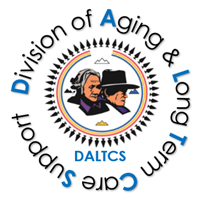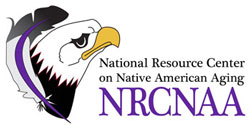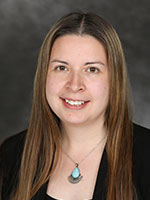Using Data to Care for Native Elders
The Navajo Nation is hoping a needs assessment survey can help shape real change for their Elders.
By Jena Pierce on
 Often
driving on dirt roads, meal delivery drivers provide a
much needed lifeline for the elderly population of the
Navajo Nation.
In rural locations where phone lines are rare, and
Internet connections are rarer, when an elderly
individual or family needs something, they share it with
their local driver. Whether it is wood to keep their
house heated during the winter; water to use for
drinking, cooking, or cleaning; or medical care; it is
the delivery drivers who are in touch with these
residents and who bring their needs and concerns to one
of 80 senior centers across three states: Arizona, New
Mexico, and Utah.
Often
driving on dirt roads, meal delivery drivers provide a
much needed lifeline for the elderly population of the
Navajo Nation.
In rural locations where phone lines are rare, and
Internet connections are rarer, when an elderly
individual or family needs something, they share it with
their local driver. Whether it is wood to keep their
house heated during the winter; water to use for
drinking, cooking, or cleaning; or medical care; it is
the delivery drivers who are in touch with these
residents and who bring their needs and concerns to one
of 80 senior centers across three states: Arizona, New
Mexico, and Utah.
Anslem Lewis, Jr., shares something his grandma reminds him of: the reason he has a job is because of the Elders on the Navajo Nation reservation, so, he needs to continue to take care of them. It is advice he has taken to heart. He uses it in his everyday work and helps to inspire the drivers and other staff that serve the Elders.
 Lewis is the interim health service administrator charged
with overseeing the Division of Aging and Long-term Care
Support for the Navajo Nation. Having worked with the
Division for three years, he is all too familiar with the
needs of the Elders that his department serves. Heat,
food, reading glasses, hearing aids, dentures, and
knowing others care for them, are some of the most
pressing needs his office sees.
Lewis is the interim health service administrator charged
with overseeing the Division of Aging and Long-term Care
Support for the Navajo Nation. Having worked with the
Division for three years, he is all too familiar with the
needs of the Elders that his department serves. Heat,
food, reading glasses, hearing aids, dentures, and
knowing others care for them, are some of the most
pressing needs his office sees.
“It goes back to our teaching,” Lewis shares. “We do as much as we can to respect our Elders, take care of them, no matter whose grandma or grandpa they are, it is something that is embedded in us as young kids.”
Lewis oversees five agencies, 80 senior centers, and a staff of 250, including drivers, cooks, program supervisors, and office staff. He is also overseeing the finance personnel, including the vital Title VI funding. And he understands the significance of grasping the needs of the elderly population.
COVID Challenges
Lewis knows he wouldn't be able to serve the large Elder community without the dedication of his staff. This was especially true throughout the pandemic, when congregate meals were halted at the senior centers. Only curbside or home-delivered meals were available.
“Big shout out to my team. If it wasn't for them, a lot of the Elders wouldn't get the supplies they need. It was the field staff, senior center staff, the supervisor, cook, and drivers; they are the ones that kept giving our Elders hope. We are thankful, without them none of this would have been possible.”
He continued talking about the current efforts, “We are still slowly trying to get out of this, trying to get back to normal. Some Elders are still afraid. This is a once-in-a-lifetime pandemic, in our lifetime, and it is something they are afraid of. This goes back to the origin stories, our traditional stories, when something this big comes around, it is taboo and telling us something, so they are probably taking more precaution than the younger generation.”
The pandemic presented several challenges for Lewis and his staff. One of their primary goals is to ensure Elders have nutritional options, so when the senior centers closed indoor dining, requests for home-delivered meals greatly increased, leading to food shortages from their vendors. They were competing with other organizations for food supplies, often vendors had limited hours, and the number of people allowed in facilities was reduced. One saving grace was that some local vendors offered a senior day, letting senior centers shop (choose the bulk items they wanted to serve) during certain hours on designated days, helping to cater to the Elder population.
Another challenge was transportation. The additional wear and tear on vehicles making the deliveries created breakdowns and increased time spent trying to secure another vehicle. Another transportation need from Elders was bringing them to get vaccinated if they wanted to, or if they were sick, they would need a ride to get tested.
The Navajo Nation, like many reservations across the country, had great loss due to the pandemic, and this included Elders and Lewis's staff.
It hit home for us, because we lost some Elders, and when it is a routine to deliver to someone and they aren't there anymore, it takes a toll.
“We lost some staff,” says Lewis, “who were still working and caught the virus. It didn't end well for them. It hit home for us, because we lost some Elders, and when it is a routine to deliver to someone and they aren't there anymore, it takes a toll. And when you lose staff, that hurts too. We lost six or seven drivers.”
The Elders really missed the socializing that COVID took from them, so Lewis's staff worked to hold five to six Elder Fests around communities to bring people together and provide lunch. To help people stay active, they have been providing some exercise activities, stress balls, exercise bands, and are working on getting more crosswords and puzzles.
Learning on the Job
Lewis has been working with the Aging Division since the early days of COVID when he was laid off from his construction job. He applied for a planner position with the Division and slowly kept moving up, to a program and project specialist, and through leadership turnover, has found himself leading the efforts to advocate and care for the elderly of the largest American Indian reservation in the U.S. After seven months, this is a position he intends to remain in until a permanent health service administrator is hired. And he plans to apply once the position gets posted.
On a daily basis, he checks in with his agency staff and has a goal of getting projects and tasks completed within a one-two day turnaround. With a staffing shortage, he finds himself doing some of the finance work, submitting documents for payments, bills, ordering food supplies, and other duties. He has meetings with stakeholders, works with personnel matters, talks to Elders when they call, and he prepares presentations for the new tribal council and the oversight committee.
When he thinks of his job in terms of knowing what to do, it has been a “crash course in a lot of stuff, and still is.” He continues to learn day by day.
Little Things, Big Rewards
 The most rewarding part of his job is when he
hears stories from the senior centers. One of the
programs allows Elders to apply for items such as reading
glasses, hearing aids, or dentures. Often Elders are not
aware of the program, so a meal delivery driver might ask
about a need. One woman was asked if she needed glasses.
Her response was that she was able to see, so it was good
enough. But when she put the glasses on and was handed a
newspaper, she was able to read the news herself. She no
longer had to rely on anyone to read it to her through
their lens. Because of a simple item, she gained some of
her independence back.
The most rewarding part of his job is when he
hears stories from the senior centers. One of the
programs allows Elders to apply for items such as reading
glasses, hearing aids, or dentures. Often Elders are not
aware of the program, so a meal delivery driver might ask
about a need. One woman was asked if she needed glasses.
Her response was that she was able to see, so it was good
enough. But when she put the glasses on and was handed a
newspaper, she was able to read the news herself. She no
longer had to rely on anyone to read it to her through
their lens. Because of a simple item, she gained some of
her independence back.
“The price of everything is going up,” Lewis says, “so we try to help out as much as we can. Sometimes Indian Health Services or Medicaid will provide services but often, we are a last resort. This program has been really successful. I think within our first quarter we served over 800 Elders with one of those three needs. I would like to advocate more with our council because that funding is based on the stock market since it's in a trust fund. If the stock market does well, we do well. I wish we could have a set allocation for that.”
It really is the little things that most of us take for granted that bring light into people's life.
He is grateful for a recent donation of 10,000 reading glasses that his department was able to distribute in January. “It really is the little things that most of us take for granted that bring light into people's life,” he said.
Title VI is a Safety Net
In 1978, the Older Americans Act was amended to include Title VI, which established programs for the provision of nutrition and supportive services for American Indians, Alaska Natives, and Native Hawaiians, according to the Administration for Community Living (ACL).
The program has since expanded to include caregiver support services. Eligible tribal organizations receive grants in support of the delivery of home- and community-based supportive services for their Elders, including nutrition services and support for family and informal caregivers.
But for the Navajo Nation, a staffing shortage is making things more challenging, and they currently do not offer caregiver support services. The Title VI Part C program helps tribes provide locally-determined systems of support services for family caregivers.
The Importance of Data
 The National Resource
Center on Native American Aging (NRCNAA), within the
Center for Rural Health, at the University of North
Dakota School of Medicine & Health Sciences, facilitates
the Title VI Needs
Assessment, Identifying Our Needs: A Survey of
Elders.
The National Resource
Center on Native American Aging (NRCNAA), within the
Center for Rural Health, at the University of North
Dakota School of Medicine & Health Sciences, facilitates
the Title VI Needs
Assessment, Identifying Our Needs: A Survey of
Elders.
This survey assists tribes, villages, and homesteads in creating a record of the health and social needs of their Elders. Survey results document the needs of Elders to help with tribal planning, long-term care discussions, and grant applications. The results also satisfy the requirement for Title VI grants from ACL, which are awarded every three years.
The following services are provided to participating organizations: survey instrument, assistance with sampling, technical support, data entry, data analysis, statistical profiles of our Elders, comparisons with national norms, and infographics.
Typically, the surveys are given to Elders at congregate meals or events. This allows for greater numbers to participate, and if they have questions, staff are available to assist. The anonymous surveys are mailed to NRCNAA to process. After the data analysis is completed, NRCNAA provides data results to participating organizations.

Dr. Collette Adamsen, the director of NRCNAA, oversees the needs assessment survey process and says the staff understood the challenges the Title VI programs had trying to complete the surveys throughout COVID. Senior centers had to move away from congregate meals as more were picked up curbside or delivered to homes. Prioritizing the health and safety of Elders, families, and staff, programs were encouraged to add measures such as COVID-19 testing, mask requirements, and distancing when Elders were brought together. These extra, temporary measures helped to put everyone more at ease while still gathering the important information needed. Now most of these measures are, thankfully, no longer needed.
In order for tribes to take part in the survey, they must have a signed tribal resolution. In a previous cycle, the Navajo Nation began the survey inquiry, but due to a lack of a tribal resolution, they were unable to get the survey results processed. This time, the Navajo Nation Council signaled their full support through the resolution.
The needs assessment survey are given every three years. During the previous cycle, over 23,000 Native Elders across the United States participated in survey.
Planning for Future Needs
When asked why the council was ready to complete the survey process this time, Lewis said, “We want to extend our contract with Title VI through the 2023-2026 cycle, but also the info you provided will play a big part in helping us plan for the future. We now have accurate and up-to-date numbers we can present to our council and oversight committee. It will lead us to where we need to be, where services will be needed in the future.”
The Elder count the Navajo Nation provided for the needs assessment was 31,741. Based on that number, a random sample size of 389 was recommended. A total of 397 surveys were completed and analyzed.
The data we are able to provide to Anslem and his team, helps them advocate for the specific needs and resources to allow them to continue to serve their Elders.
“We were very pleased with the number of surveys we received from the Navajo Nation,” said Adamsen. “As the largest reservation in the country, we understand the importance of finding out what the Elders might be missing, or what they are pleased with. The data we are able to provide to Anslem and his team, helps them advocate for the specific needs and resources to allow them to continue to serve their Elders.”
Lewis continued, “The survey was able to show us the illnesses, how much the Elders rely on our services, the monetary means available, and the fact that the majority of our Elders are probably below the poverty lines. Heat, electricity, water, that is taken for granted in the city, is needed here. The survey got us all of this information.”
A Guide to Understanding the NRCNAA Needs Assessment is a fact sheet that demonstrates the growth, reach, and benefits of tribes participating in the survey.
Building Relationships and Working Together
Lewis doesn't hold back when he speaks of the importance of working with NRCNAA. The outreach, the support, and helping him work within the structure of the Navajo Nation has been invaluable.
“The information they provided,” Lewis said, “allowed us to present to our council, our president, and other branches and show those numbers (from the survey) cover the majority of our needs in the field. The transparency of the survey is awesome, as well as having help form others. Cynthia LaCounte, with ACL, is constantly reaching out to help us find money through other grants, help us maintain what we need to provide for our Elders, and hopefully grow.”
Throughout all of the daily tasks, challenges, and rewards that come with his position, Lewis remembers the reminder from his grandma about taking care of Elders.
“We try our best to have them be self-sufficient, and provide the services we can, to keep them at home. We are only getting better. I would like to provide more and more services that are out there. Hopefully in the next couple years, we will be a strong Aging department.”


 is the communications manager at the Center for Rural
Health at the University of North Dakota School of
Medicine & Health Sciences in Grand Forks.
is the communications manager at the Center for Rural
Health at the University of North Dakota School of
Medicine & Health Sciences in Grand Forks.



